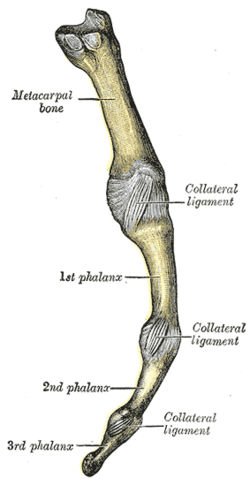- Collateral ligaments of metacarpophalangeal articulations
-
Collateral ligaments of metacarpophalangeal articulations 
Metacarpophalangeal articulation and articulations of digit. Ulnar aspect. Latin ligamenta collateralia articulationum metacarpophalangealium Gray's subject #90 332 In human anatomy, the radial (RCL) and ulnar (UCL) collateral ligaments of the metacarpophalangeal joints (MCP) of the hand are the primary stabilisers of the MCP joints.[1] They have two parts: the cord-like collateral ligaments proper located more dorsally and the accessory collateral ligaments located more volarly.[2]
Contents
Origin and insertion
The collateral ligaments originate on depressions on each side of the metacarpal heads dorsal to axis of rotation. From there, they extend obliquely and distally to their insertions onto tubercles at the base of the proximal phalanx. The accessory collateral ligaments originate volar to the collateral ligaments and are inserted on the volar or palmar plate. [1]
Function
Due to the relation between their insertions on the sides of the metacarpal head and the axis of rotation in the joint, the collateral ligaments are taut in flexion but lax in extension, while the accessory collateral ligaments are lax in flexion but taut in extension. [1] The collateral ligaments are lengthened 3-4 mm when the joint flexes 0-80° while the accessory collateral ligaments are shortened 1-2 mm. During hyperextension the accessory ligaments are lengthened while the proper ligaments are shortened. [2] As a result, the joint is stable during full flexion while the relaxed collateral ligaments allows lateral and rotation movements during extension. [3]
The tendons of interosseous and lumbricales add to the lateral stability of the joint. [1]
Additional images
Metacarpophalangeal articulation and articulations of digit. Volar aspect.Notes
- ^ a b c d Berger & Weiss 2004, p. 175
- ^ a b Austin 2005, pp. 321–22
- ^ Brüser & Gilbert 1999, pp. 155–56
References
- Austin, Noelle M. (2005). "Chapter 9: The Wrist and Hand Complex". In Levangie, Pamela K.; Norkin, Cynthia C.. Joint Structure and Function: A Comprehensive Analysis (4th ed.). Philadelphia: F. A. Davis Company. ISBN 0-8036-1191-9.
- Berger, Richard A.; Weiss, Arnold-Peter C. (2004). Hand Surgery. Lippincott Williams & Wilkins. ISBN 9780781728744. http://books.google.com/books?id=b7-kkx-8eqYC&pg=PA175.
- Brüser, Peter; Gilbert, Alain (1999). Finger bone and joint injuries. Taylor & Francis. ISBN 9781853176906. http://books.google.com/books?id=-pzGRMvXFzAC&pg=PA155.
Joints and ligaments of upper limbs (TA A03.5, GA 3.313) Shoulder Elbow Radial collateralUlnar collateralForearm Joints of hand Dorsal radiocarpal/Palmar radiocarpal · Dorsal ulnocarpal/Palmar ulnocarpal · Ulnar collateral/Radial collateralRadiate carpal · Dorsal intercarpal · Palmar intercarpal · Interosseous intercarpal · Scapholunate · Pisiform joint (Pisohamate, Pisometacarpal)Collateral · PalmarOtherM: JNT
anat(h/c, u, t, l)/phys
noco(arth/defr/back/soft)/cong, sysi/epon, injr
proc, drug(M01C, M4)
Categories:- Ligaments of the upper limb
Wikimedia Foundation. 2010.

